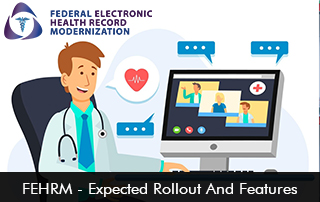The Federal Electronic Health Record Modernization (FEHRM) program is a transformative initiative aimed at streamlining and standardizing electronic health record (EHR) software across federal healthcare facilities. As healthcare practitioners, understanding the expected rollout timeline and key features of FEHRM is crucial for ensuring a smooth transition and optimizing patient care.
In this blog, we’ll explore:
-
The background and goals of FEHRM
-
The expected rollout timeline
-
Key features of the modernized EHR system
-
Challenges and considerations for healthcare providers
What is FEHRM?
Background and Purpose of FEHRM
The FEHRM program was established in 2019 to replace outdated, siloed EHR systems used by federal agencies, including the Department of Defense (DoD), Department of Veterans Affairs (VA), and Department of Homeland Security’s U.S. Coast Guard, with a single, interoperable EHR solution.
The primary goals of FEHRM include:
-
Enhancing interoperability between federal and private-sector healthcare providers
-
Improving care coordination for military service members, veterans, and their families
-
Reducing the administrative burden on clinicians
-
Ensuring data security and compliance with modern healthcare standards
The Shift to Oracle Cerner
After the DoD’s successful deployment of MHS GENESIS (based on Oracle Cerner’s EHR platform), the VA also adopted the same system, moving away from its legacy VistA system. This shift ensures seamless data exchange between DoD and VA facilities, a long-standing challenge in military and veteran healthcare.
Expected FEHRM Rollout Timeline
The FEHRM rollout is a multi-year effort, with deployments occurring in waves across federal healthcare facilities. While timelines have faced delays due to technical and operational challenges, here’s the current expected schedule:
Phase 1: Initial FEHRM Deployment (2020–2023)
-
DoD’s MHS GENESIS completed its initial deployment across all military treatment facilities (MTFs) by the end of 2023.
-
The VA began its rollout in 2020, with early sites including:
-
Mann-Grandstaff VA Medical Center (Spokane, WA)
-
Columbus VA (Ohio)
-
Roseburg VA (Oregon)
-
Phase 2: Broader VA Rollout (2024–2025)
-
The VA plans to accelerate deployments in 2024, targeting additional facilities such as:
-
VA Ann Arbor Healthcare System (Michigan)
-
VA Central Ohio Healthcare System
-
VA Walla Walla (Washington)
-
-
Full deployment across all VA sites is expected by 2028, though this may shift based on ongoing evaluations.
Phase 3: Coast Guard and Other Federal Agencies (2025–Beyond)
-
The U.S. Coast Guard is expected to transition to the new EHR system by 2025.
-
Other federal healthcare providers, including the Indian Health Service (IHS), may also adopt the FEHRM framework in the future.
Potential Delays and Adjustments
-
The VA has paused some deployments to address usability and patient safety concerns raised by early-adopting sites.
-
Future rollout schedules may be adjusted based on feedback from clinicians and IT teams.
Key Features of the FEHRM System
The new FEHRM-integrated EHR software (Oracle Cerner) introduces several improvements over legacy systems. Here’s what healthcare practitioners can expect:
1. Enhanced Interoperability
Seamless DoD-VA Data Sharing
-
Single patient record across military and VA facilities eliminates duplicate data entry.
-
Real-time updates ensure clinicians have the latest medical history, prescriptions, and test results.
FHIR API Support
-
The system supports Fast Healthcare Interoperability Resources (FHIR), enabling secure data exchange with private-sector providers and telehealth platforms.
2. Improved Clinical Workflows
Unified Patient Portal
-
Patients and providers can access records via a single portal (My HealtheVet for VA, MHS GENESIS Patient Portal for DoD).
-
Secure messaging and appointment scheduling reduce administrative overhead.
AI-Powered Decision Support
-
Predictive analytics helps identify at-risk patients.
-
Clinical decision support (CDS) tools provide evidence-based treatment recommendations.
3. Patient Safety and FEHRM Compliance
Reduced Medication Errors
-
Barcode medication administration (BCMA) integration ensures accurate dispensing.
-
Drug interaction alerts minimize prescription risks.
HIPAA and Cybersecurity Compliance
-
Stronger encryption and multi-factor authentication (MFA) protect sensitive data.
-
Audit trails track all access to patient records.
4. FEHRM Telehealth and Remote Care Integration
-
Virtual visit scheduling within the EHR.
-
Remote patient monitoring (RPM) capabilities for chronic disease management.
Challenges and Considerations of FEHRM for Practitioners
While FEHRM promises significant improvements, practitioners should be aware of potential hurdles:
1. Training and Adoption
-
Steep learning curve for providers accustomed to legacy systems like VistA.
-
Ongoing training programs will be essential for smooth transitions.
2. Temporary Workflow Disruptions
-
Downtime procedures during system cutovers may slow operations.
-
Data migration issues could lead to temporary gaps in records.
3. Patient Communication
-
Educating veterans and active-duty members on new patient portal features will be crucial.
-
Addressing concerns about data privacy and access.
4. Ongoing FEHRM System Optimizations
-
User feedback will drive future updates to improve usability.
-
Customization options may vary by facility.
Preparing for the Future of FEHRM
The FEHRM program represents a major leap forward in federal healthcare IT, promising better interoperability, efficiency, and patient outcomes. While the rollout has faced delays, the long-term benefits—seamless care transitions, reduced clinician burnout, and enhanced data security—make it a critical evolution for military and VA health systems.
As healthcare practitioners, staying informed about deployment timelines, key features, and potential challenges will help ensure a smoother transition. Proactive training, workflow adjustments, and patient education will be key to maximizing the system’s potential.
For the latest updates, practitioners should monitor official FEHRM communications from the VA, DoD, and Oracle Cerner. The future of federal EHRs is on the horizon—and with the right preparation, healthcare teams can lead the way in delivering better care.








